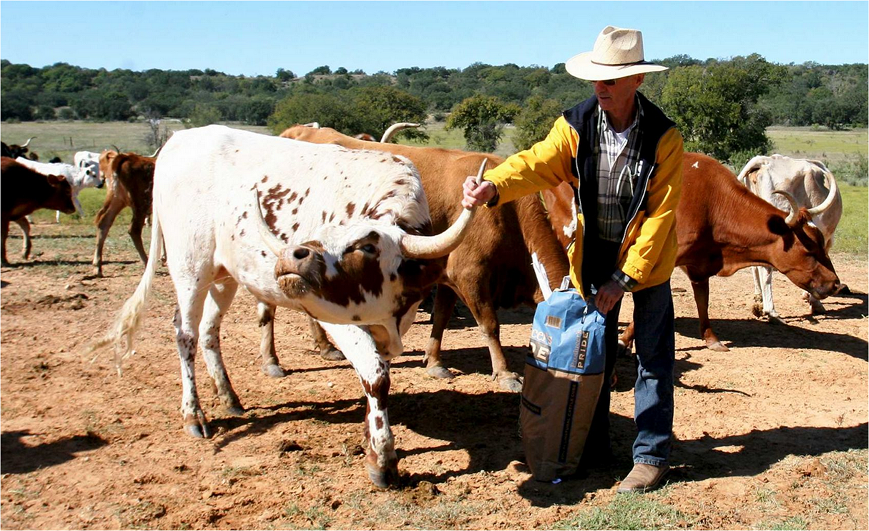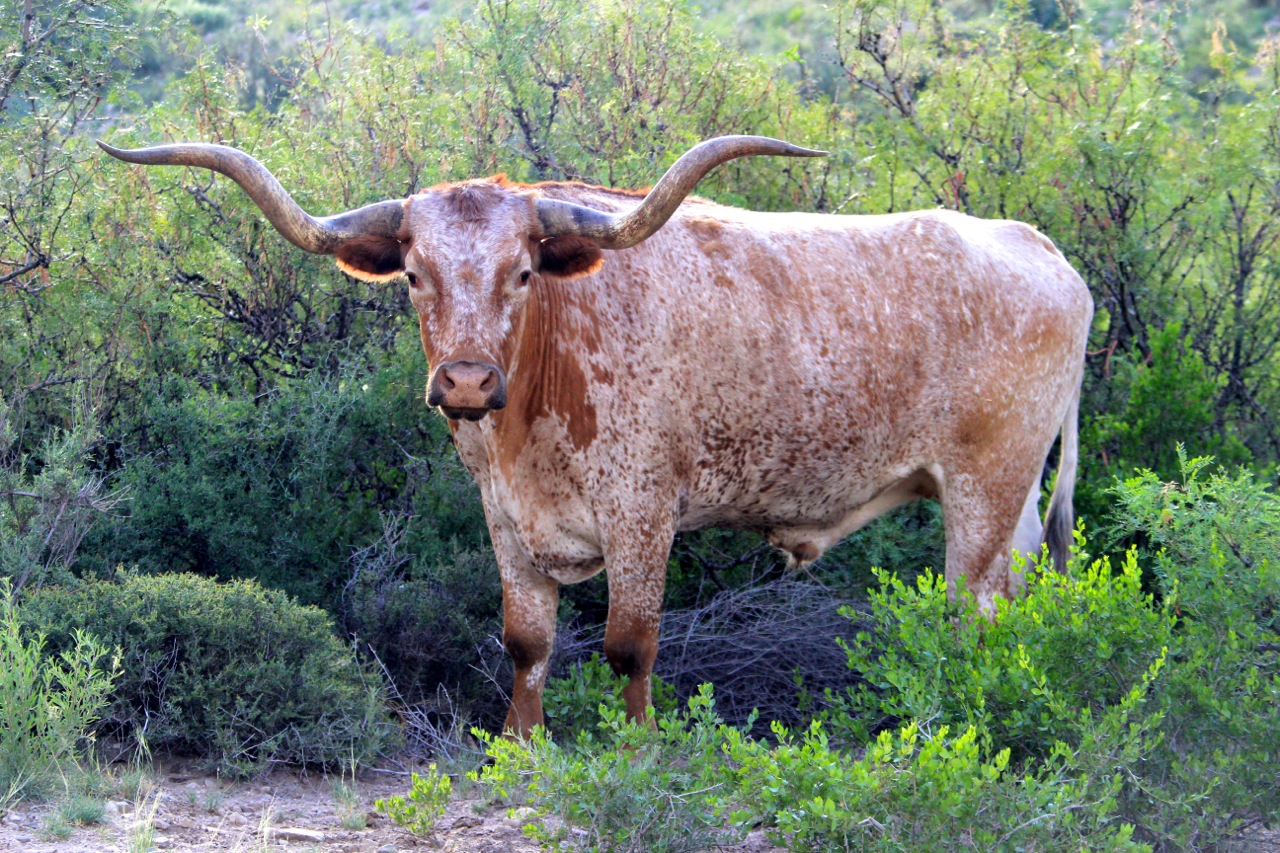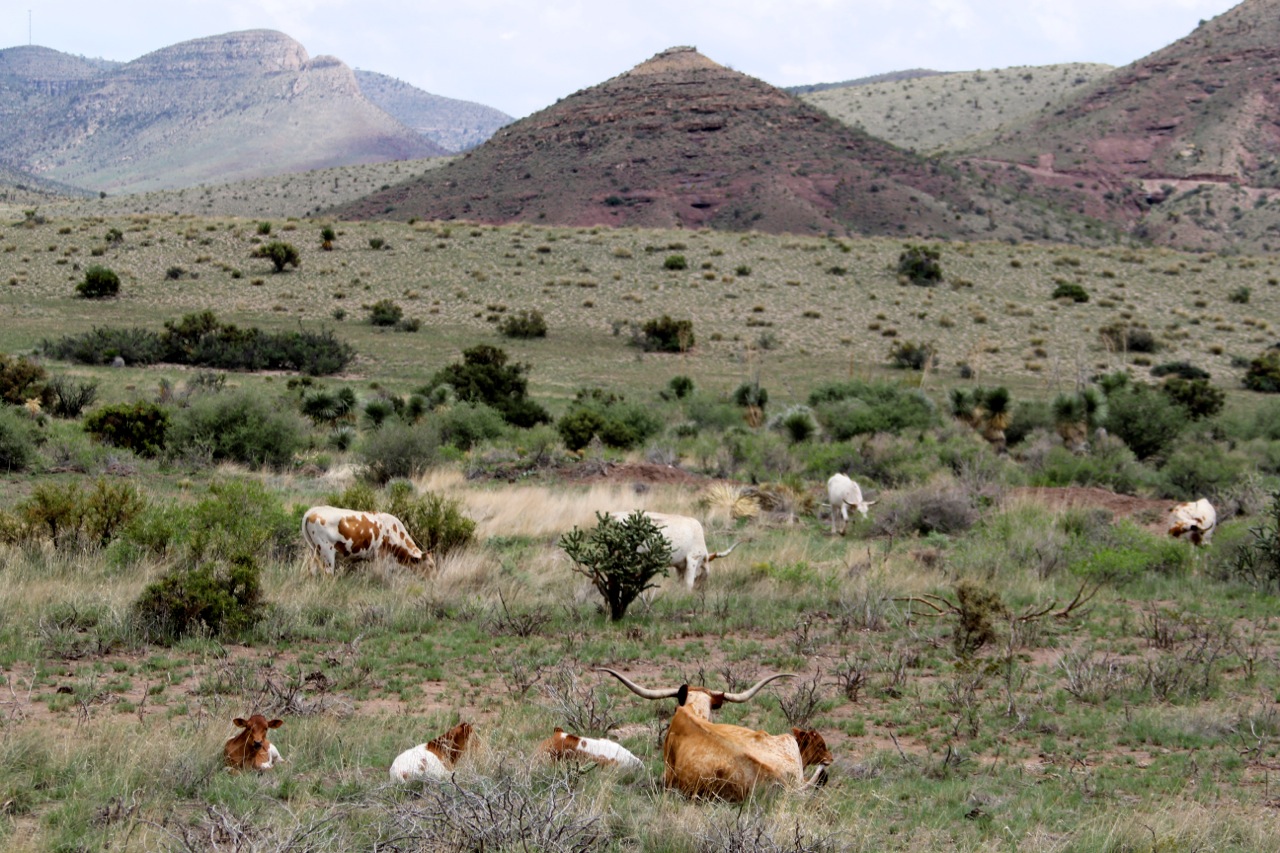Attacking Biodiversity on Texas' Public Lands: Wild Longhorns May be Nearing the End of the Trail in Park

NOTE: Story originally appeared in the SA Express News,authored by John MacCormack, October 23, 2013.
PRESIDIO — When the Texas Parks and Wildlife Department bought the Big Bend Ranch from Houston oilman Robert Anderson in 1988, it acquired 215,000 acres of high desert wilderness complete with an extinct volcano, waterfall and wild game.
Environmentalists and state officials were ecstatic about the vast, unspoiled prize, but the small herd of longhorns that came with the real estate quickly became the unwelcome stepchild.
“The environmental groups didn’t want the cattle. They wanted to have this trackless land, to make it pristine and return it to its original ecosystem. The cattle represented the opposite of what they wanted to achieve,” recalled John L. Guldemann, 60, the ranch foreman who became the park’s first superintendent.
More than two decades later, the controversy is flaring again, but now there are very few longhorns left to fight about.
“They’ve been selling them off clandestinely, if you will,” said Charles “Doc” Anderson, a Waco-area state legislator who wants to preserve the park herd.
“I went out to the Big Bend Ranch and overflew it in July, and I counted 33 head from the original herd of in excess of 200.”
From the start, one mostly urban camp objected to the cattle, in part because they are not a native species and are accused of being destructive. Others in ranch country saw them as living symbols of the state’s rural heritage.
In 1995, the Texas Parks and Wildlife Commission voted unanimously to remove the cattle, but they got a temporary legislative reprieve. The longhorns stayed put, and the twice annual “City Slicker” roundups proved very popular with tourists who paid more than $900 for the adventure.
“This was not a trail ride following cow butts. It was authentic. The cattle were running around on 40,000 to 50,000 acres,” said stables owner Linda Walker, who provided horses and wranglers.
“They were wildly successful. People loved it,” she said of the roundups, which ended two years ago.
But the cultural and philosophical differences that underlie the conflict — crudely reducible to mountain biking and bighorn sheep vs. footloose, old-timey cattle — never went away.
The agency’s latest longhorn management plan calls for elimination of the park herd, and by last fall, all but the wiliest had been rounded up and sold.
After Doc Anderson got wind of it, he introduced a bill to protect the herd, but the most he accomplished was to get 50 legislators to sign a letter in favor of the longhorns that was sent to Gov. Rick Perry, who took no action.
“The issue is, these animals don’t belong to the management of Texas Parks and Wildlife Department. They belong to the folks of Texas,” Anderson said.
For now, there is a temporary truce, with agency officials agreeing to not round up the remaining wild cattle on a park that has grown to more than 300,000 acres.
Park Superintendent Barrett Durst, 33, said there are good reasons to get rid of them, starting with the park’s mission statement “to manage and conserve the natural and cultural resources.”
“Preserving a native Chihuahuan Desert habitat doesn’t entail maintaining a free-ranging herd of Texas longhorns,” he said, adding that they can be destructive.
“We have an archeological site that the longhorn cattle just devastated with their hooves. They also defecate in springs that backpackers plan on using as a water source,” he said, adding, the longhorns are a drain on the park’s limited resources.
“In the 31/2 years I’ve been out here, I’ve not had one individual walk through the office or call on the telephone and ask, ‘Where are the longhorns? Where can we see them?’ It just doesn’t happen.”
While the tourist roundups were popular, he said, they were not without risk.
“In October 2011, we did one of those and one of the bulls got so wild it tried to gore one of my staff member’s horses. At that point it became unsafe to do anything,” he said.
Piece of history
Once a familiar sight grazing in the brush around park headquarters, the only longhorns seen on a recent visit were five being held in a small corral. Wary and compact, they bore little resemblance to more familiar bulky beef breeds.
Kevin Good, an agency official in Austin, said he believes most of the longhorns that are still loose eventually will be rounded up and sold, leaving a small group of tamer, neutered animals in a large fenced pasture for the tourists.
“Longhorn cattle continue to be a part of the interpretive and educational experience at Big Bend Ranch,” Good wrote in an e-mail.
“The park is making the longhorn herd more accessible to park visitors, while also acting to protect sensitive riparian areas and focus staff resource on priority needs,” he added.
For groups like the Sierra Club, the reduction of the herd is long overdue.
“Based on what we have heard, these are not good examples of the breed. The animals at the Big Bend Ranch State Park are not part of the state’s official herd,” said Evelyn Merz, the conservation chair of the Lone Star Chapter of the Sierra Club.
Merz, who admitted she is no judge of cattle, cited historical overgrazing and continuing damage to water sources as reasons to reduce the herd.
However, to Carlos Nieto, a prominent citizen of nearby Presidio, the elimination of the herd is a slap in the face to local sentiments and the region’s ranching history.
“These damned animals were introduced by the Spaniards hundreds of year ago. They’ve been here forever. The sad part is that locals have little to no input on what happens at the state park, and it’s in our backyard,” he said.
“We’re growing up digital and on concrete, and losing that (herd) is like losing a piece of our history you can only see in books. Now they are building bike trails and that kind of crap, imposing city values on the country.”
Hides and tallow
For most Texans, the word longhorn evokes the amusing image of Bevo, the immense and docile mascot of the University of Texas that each fall appears during football games at Darrell Royal Stadium.
But Bevo, a burnt-orange steer that weighs more than a ton and has a 78-inch span of horns, bears little resemblance to the nimble fence-jumpers at the state park or to their hardy Spanish ancestors.
In his book, “The Longhorns,” published in 1941, J. Frank Dobie elevated the longhorn to near mythical status as a canny frontier creature capable of thriving in the harshest of conditions, with no help from man.
“The Texas Longhorn made more history than any other breed of cattle the civilized world has known. As an animal in the realm of natural history, he was the peer of the bison or grizzly bear. As a social factor, his influence on men was extraordinary,” the book begins.
As Dobie notes, the first Spanish cattle arrived in the New World in 1493 with Columbus on his second voyage. In 1540, Coronado brought them north across the Rio Grande on his great search for the cities of gold.
Others came with the Spanish missions to Texas and beyond, and those that slipped away from their human masters proved quite capable of surviving in the brush and grasslands of the Southwest.
Fast forward three centuries and the region between San Antonio and the Rio Grande was teeming with vast herds of wild, sharp-horned cattle, free to anyone who could put a rope on them or a bullet through them for their hides and tallow.
And in the brutally hard years after the Civil War, it was beef that kept Texas economically afloat as millions of longhorns were rounded up and sent north, east and west in epic drives.
“Ten million cattle, it has been authoritatively estimated, were driven over (the trails) between 1866 and 1890,” wrote Dobie.
But that colorful chapter of Texas history was short-lived.
The coming of the railroad and other changes ended the drives, leaving only a rich lode to mine for future Western writers and filmmakers, with Larry McMurtry’s “Lonesome Dove,” the prime example.
As the open range was fenced and English breeds were introduced, the wild Texas cattle began to vanish.
By the 1920s, Dobie, Sid Richardson and several others became alarmed and took pains to gather and preserve the best examples.
Species of wildlife
Bubba Sullivan of Midland, president of the Cattlemen’s Texas Longhorn Conservancy said that for years his organization worked closely with park officials and their longhorns, which he says are very pure examples based on blood typing and genetic testing.
“I know that we offered to do whatever we could to maintain that herd, and they just swept us onto the floor and said, ‘No, we’re getting rid of them,’” he recalled.
Sullivan said he finds the reasons for removing them to be hollow.
“They say that the cattle are hurting the springs. How are those cattle tromping around in them springs hurting them any more than a bighorn sheep?” he asked.
A proposal to have the state lend some of the park cattle to the conservancy fell through.
“I’m passionate about those animals. Before Doc Anderson got in there, we thought it was over, and that’s why we bought a bunch of them,” he said.
In mid-October, several dozen conservancy members gathered in Brownwood to inspect about 30 Big Bend Ranch cattle that were purchased last year. The animals came running when called and ate range cubes out of children’s hands.
“These are historically correct and genetically pure. Sadly, most of the longhorns people see today are nothing like the ones on the ranch,” remarked Frank Sharp, a conservancy member.
Other groups, he said, breed strictly for the massive horns, with no thought of bloodlines.
“There’s everything in the world crossed into the modern longhorn. You can’t help but suspect some of the African breeds, like Watusi, or some of that old Brahma cattle,” he said.
No matter what the outcome of the debate over the park herd, some think the remaining wild longhorns may be there to stay.
Mike Hill, a former regional supervisor for the parks department, recalls a group of about 40 in Terneros Canyon that refused to surrender at one of the last roundups.
“There were six or eight of us trying to get them out of that creek bed, and they didn’t want to go. They knew the country better than we did, so they broke back on us,” he recalled.
Hill said he doubts anyone can bring in these renegades.
“The country is rougher than hell, and those particular cattle must have a little bit of goat in them. They can go places that a crazy man on a horse he doesn’t care about can’t follow,” he said.
The debate was simmering while Hill was with the agency, and he held the unpopular opinion that they had a place at the park, hungry mountain lions and all, where a longhorn still could be a longhorn.
“I think they’ll always be there and I take a perverse pleasure in it. I just admire the animal. Longhorns are a very big part of Texas history. I do not think they ought to be just a yard ornament for rich people,” he said.
Former superintendent Guldemann says the agency may have created an intractable problem for itself in recent years by allowing them to become feral.
“These cattle are the only kind that can survive out there. They will become like another species of wildlife,” he said, adding that capturing them may be impossible.
“They’d have to go after them with a helicopter and guns, and they won’t do that. They tried that with the burros,” he said, referring to a 2007 episode in which agency sharpshooters killed dozens of burros.
Superintendent Durst, however, won’t concede defeat.
“There are real cowboys in Alpine who do this, and people who fly helicopters. So we could push ’em with helicopters and trap them,” he said.
“If you watch the History channel, there are also people in Australia who do this, round up wild cattle using helicopters. It’s just finding the right people,” he said.
jmaccormack@express-news.net
Invasion Biology: The Crackpot “Science” of Wild Longhorn Removals
“Folks who ain’t got ideas of their own should be mighty careful whose they borrow…” cowboy saying
In discussing Invasion Biology’s origins, it is not my intention to attribute political affiliations or personal convictions to any person or group.
Ecology as a formal science was born in Germany in the early 1800s. Though visionary in many ways, it was deeply influenced by xenophobic nationalistic beliefs or a pervasive fear of outsiders, which made genetic purity a priority. As a sociopolitical policy prevalent in the 19th Century even in the United States, it favored the interests of established inhabitants over those of immigrants.
Incalculable misery came from these ideas when they were used against human groups. People have tried to remove this poisonous nativist thinking from our social and political venues, but have failed to address similar beliefs in ecology. As a result, these ideas continue to survive in ecology as an authoritarian green movement, which in alliance with big government, agribusiness and education has spread across the world as the superstitious basis for what today is called “invasion biology.”
Reflecting its nativist origins, invasion biology rests on the superstitious belief that the world is threatened by thousands of “aggressive alien invaders.” Any living thing that is not “native” is, by definition, “harmful.” While only “natives” are good, if they too are “invasive” or “aggressive,” then “natives” like “aliens” also are “unnatural” and guilty of doing “harm” to “integrity” and “ecosystem health.”
Forty years ago, the emerging environmental movement rallied around common sense concerns about the effect of poisons, bulldozers, chainsaws and rifles on habitat and wildlife.
Today, the most discussed environmental issue after climate change is invasive species. And, in a complete turnaround of focus, the solution offered by a hijacked environmental movement, which has embraced the invasion beliefs, is poison, bulldozers, chainsaws, helicopters and auto-rifles!
Ecologically-beneficial wild burros including this jenny, much beloved by local communities and Park visitors, were eradicated pursuant to the same thinking being applied to longhorn. Park managers believed they “harm” bighorn sheep, which were being reintroduced, and that they are “unnatural”, “invasive”, “aggressive”, and harm “eco-system health”.
Since “alien, native, invasive, aggressive, unnatural, harm, integrity, eco-system health” etc. are not defined they can neither be tested, nor used to develop operating rules for practices. They are useless in predicting outcomes. But they produce what most government agencies can only dream of: full employment in an ever-growing, perpetual, unwinnable war against countless enemies, identified as they choose and redefined as they wish, resulting in a river of public funding for agrochemical companies, agencies, researchers and wildlife “managers.”
On public land that is slowly dying from lack of animal impact, we are attacking biodiversity, in this case wild longhorns, based on a mishmash of superstition, opinions and self-interest disguised by jargon to sound scientific. The public has funded the scientific community because we trusted it to act objectively, relying on the evidentiary principles of science. When we discover the scientific community, those we trusted, have instead played us false, it takes common sense, not graduate degrees, to reach appropriate conclusions and an infusion of conviction and courage to act on them.






